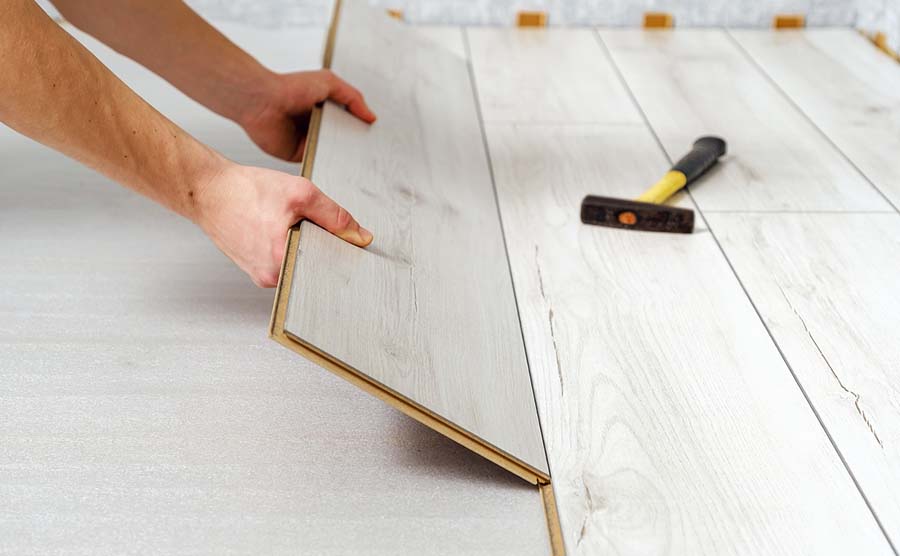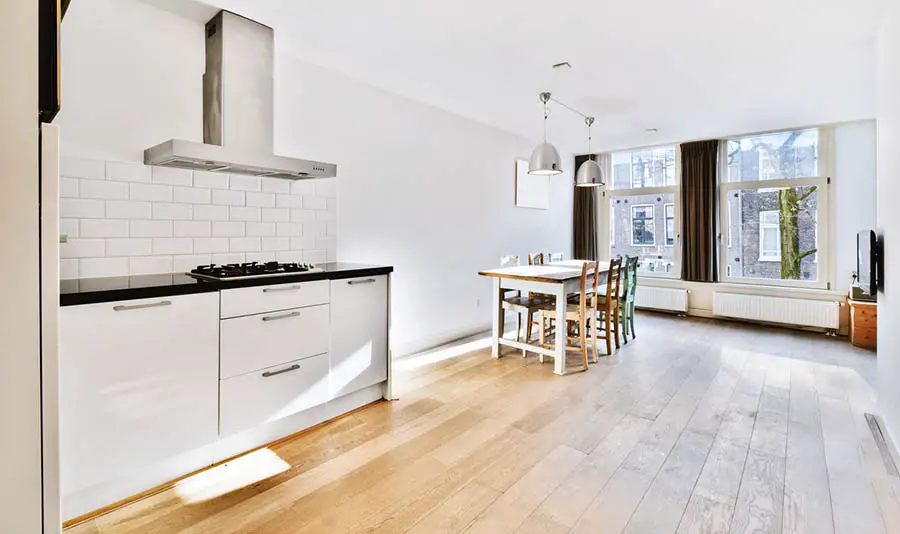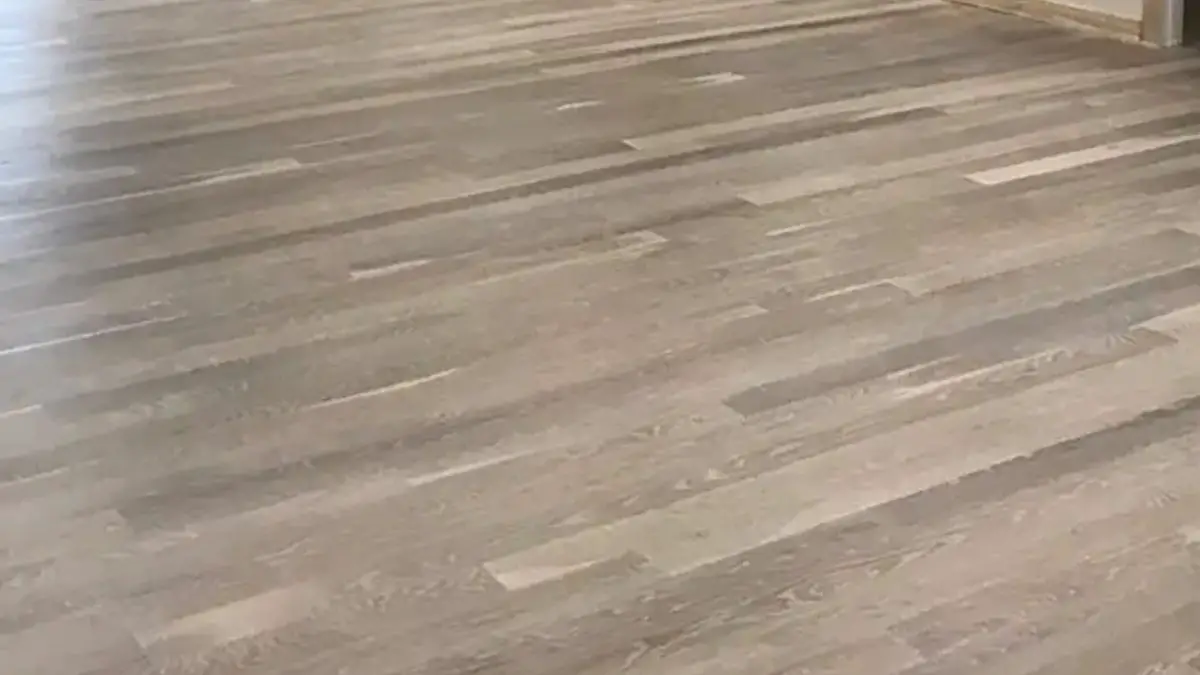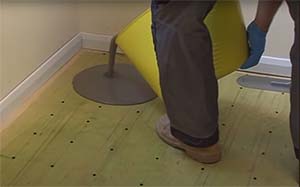
Colors are a big part of what brings life to a home. From simply rearranging your furniture and appliances to painting your walls with a fresh coat of paint, there’s just so much you can do to give your home a new feel and vibe. But what if a laminate floor is what you have? Is it still possible to change its color?
You can change the color of your laminate floors by staining, painting, replacing them. Most people choose to recolor their laminate floors when they begin to look old, unattractive, or want a different color in their home. Once done, it’s usually best to apply a sealant to your laminate floors.
It is worth noting, though, that laminate is not like wood. It is quite different and thus, requires a different approach, especially when you choose to paint or stain it. In this article, I will discuss the various characteristics of laminate and how you can change your laminate flooring successfully.
How Can You Change the Color of Laminate Flooring?
You change the color of your laminate floors by:
- Staining
- Painting
- Replacing
What you opt for will determine some of the steps you take.
But first, ensure that the laminate floor is clear. So, if necessary, you must ensure first that pets, children, and furniture are absent from the room you will be working in. In addition, you must wear the correct protective clothing.
1. Determine Your Budget
The first order of business is to determine how much money you intend to spend to change the laminate flooring color.
To determine your budget, it would help if you considered the cost of labor and materials in case you want to replace the floor. Also, you must factor in the floor area you will be working on.
Generally, the larger the area you will be working on, the more it will cost to change the laminate floor color.
2. Determine the Method You Want to Use
Do you want to replace your laminate floor? Or would you prefer to stain or paint it instead? Any of the options you select will require you to put in some work. But you also need to consider other issues.
For example, if your laminate flooring is nearing the end of its life, is it worth it to paint or stain it? Wouldn’t it make more sense to replace it instead? On the other hand, if your laminate floor is pretty new, it would make more sense to change its color without replacing it so you can get some more use out of it.
So, think about it carefully when deciding how to change the color of your laminate flooring.
3. Clean the Laminate Floor
It helps to clean the laminate floor if you want to stain or paint it.
You can do that by using a broom or vacuum cleaner to remove the dirt and debris. If it is in good condition, you can finish by mopping and drying the floor in readiness for other activities. Where stubborn stains are concerned, use a gentle cleaning solution to get rid of them.
4. Repair the Laminate Floor
If you have no intention of replacing your laminate floor to change its color, you need to fix any issues it may have first before doing anything else. Cleaning enables you to see the areas that need repair much more quickly.
So, if the floor is not in excellent condition throughout, consider repairing it after cleaning. You may need to patch up the laminate flooring, fix minor chips, cracks, dents, or replace some portions.
You can buy a laminate flooring patching compound from your local home improvement store. But you need to make sure it is similar in color to your existing laminate floor. Then follow the instructions on the kit to fill in the gaps within your laminate floor.
Typically, this step involves using a putty knife to push the compound into the spaces within your flooring. Sometimes, though, you may need to use a heating tool instead. Then you can sand the worked-on section down until it is level with the surrounding areas.
If large sections of your laminate floor are damaged, you may need to replace them. In that case, you may need to buy several laminate planks, cut out or disassemble the damaged sections, then install the new planks and glue them in place.
5. Sand the Laminate Flooring
Whether you choose to paint or stain your laminate flooring, it would be wise to sand it down. And the goal is to remove the glossy finish until the surface becomes dull. The roughness helps the stains stick better.
Do bear in mind, though, that laminate is never meant to be refinished like hardwood. So, sanding it will likely interfere with its overall appearance and functionality.
However, sanding enables the stain finish or paint to adhere better to the flooring when you apply it. During this stage, consider using an orbital sander with fine-grit sanding paper. But if you don’t mind the additional work, you can sand the floor by hand.
6. Clean the Floor Again
Sanding tends to cause dust, which you need to clean off.
So, once the process is complete, you should vacuum, mop, and dry the sanded laminate floor. But ensure your mop does not drip water to prevent damage to the laminate layers underneath.
7. Prime the Laminate Floor
You should prime the sanded laminate floors if you intend to paint them. However, the stage is unnecessary if you want to stain them.
Priming helps the paint adhere to the laminate. But the coat should not be too thick or too thin. And you will need to apply at least two coats of your primer of choice.
The general recommendation is that you use an oil-based primer. It will help seal the sanded laminate and make it more impervious to water, thus preventing water damage. Also, oil-based primers accept both water- and oil-based paint coats.
Do remember, though, that oil-based primers are not very eco-friendly. They release high levels of VOCs and require you to use harsh chemicals when cleaning.
Before you paint, you must ensure you give your primers enough time to dry. In the meantime, you should keep that area clean and free of traffic.
Primer/sealers, which perform the double job of priming and sealing surfaces, are an excellent option. So, consider them for your laminate floors.
8. Stain or Paint
Once the area has been sanded and cleaned, you can stain it without priming. Ensure you use a laminate stain finish and not a product meant for wood. Opt for tints that resemble the color you desire and apply at least three coats while allowing enough time between each coat for proper drying.
When staining a laminate floor, remember that it is much easier to use a darker color than a light one due to the existing designs on the upper plank layers. They are usually difficult to hide.
Alternatively, you can paint your laminate floor using your desired color. But you can only do so after priming the floor surface. Usually, people need at least two or three coats for excellent results.
And ensure you follow the lines of the laminate planks rather than painting perpendicular to them. You could use a foam roller during this step to help you spread the paint evenly.
When painting on laminate floors, you can use latex paints. They are very compatible with oil-based primers.
Once the staining is done, wait for two or three days before doing anything else on that surface.
9. Seal the Laminate Floor
Once your paint has dried according to the manufacturer’s instructions, you can apply a sealer. Typically, the paint curing times could be as long as a week. Afterward, sealing the refinished floor will make it withstand wear and tear better. The paint job will be more durable as a result.
Generally, polyurethane sealants are the best option, especially if you want a glossy finish. Polyacrylic sealants are also worth considering. You can apply the first coat, sand it down a little bit after it dries, and then add the second coat.
You do not have to seal the floor if you opt for a laminate stain finish.
10. Finish Up
Once you are done with staining or painting, you can finish up.
Clear the space of the tools and materials you have been using. Then keep everyone and everything away as you wait for the curing process to be complete.
11. Bring Back the Furniture and Rugs
Once the stain or paint has finished curing, it is ready for use.
You can bring back your furniture, rugs, and other pieces that belong in the space you have worked on.
What Exactly Is Laminate Flooring?

Before deciding on the new color for your laminate floor, let’s first get to know this type of flooring better. Laminate flooring is typically made of a composite consisting of four layers.
The bottom layers consist of fiberboard and melanin resin materials. These layers help protect the flooring against moisture penetration, provide structural stability, and resist indents.
The top layer is transparent and made of aluminum oxide. It covers an applique photographic layer that simulates materials such as stone or wood. Below are some of the unique characteristics of a laminate floor.
1. Laminate Flooring Is Permeable To Water
While laminate has layers that provide a moisture barrier, it is not fully waterproof. The inner layers, which consist of recycled wood materials, can allow water in. Should that happen, the layers will become water damaged.
So, when you want to change the color of laminate flooring using liquids, such as paint, you must consider its permeability to water in mind.
2. Laminate Has Some Moisture Resistance
Laminate has a decent amount of moisture resistance. The flooring can withstand some surface spills for short durations. So long as you clean the water on the surface fast, it will not soak into the layers underneath.
For that reason, you need to find ways of sealing the laminate floor when you change its color, especially if you stain it. That’s because staining involves the scuffing of the outer layer, which renders it more vulnerable to moisture.
3. Laminate Flooring Is Scratch Resistant
Laminate is a material that is scratch-resistant to a great degree, making it an excellent flooring option for homes with pets and children.
If you intend to change your laminate floor’s color by painting or staining, its scratch resistance qualities will make your work harder. So, that is something to think about.
4. Laminate Is Durable
You can enjoy the same laminate flooring for about 15 to 25 years. That is a good thing if you are content with having the same color on the floor for decades.
But if you are prone to changing your home’s design theme often, the durability of laminate may work against you. When laminate flooring is not well taken care of, it will only last for about ten years. And if you keep working on it often to change its color, that may happen.
5. Laminate Is Eco-Friendly
Homeowners who are conscious of their impact on the world around them may opt for laminate. That is because it uses fewer raw materials in the manufacturing process.
In addition, the flooring option requires no adhesives that contain harmful volatile compounds (VOCs). As a result, it is one of the best options for people who want to reduce their exposure to allergens.
Many stains and paints contain harmful chemicals that are harmful to the environment. And using them could make your home less eco-friendly.
6. Laminate Is Easy To Install
Laminate flooring is one of the best options for DIY enthusiasts because of the ease of installation. You don’t need to use mortar, grout, or any adhesives. You can install the laminate planks row by row with a few tools until the project is complete.
Laminate flooring’s ease of installation is a crucial factor to consider, depending on how much work you are willing to put in when changing the color of a laminate floor. You may end up deciding that replacing the entire floor is worth it since it is pretty easy to do so.
7. Laminate Is Low Maintenance
Another characteristic you should consider concerning laminate flooring is how easy it is to maintain it. While you cannot refinish it like hardwood, you can easily care for it.
Cleaning laminate flooring is a breeze and requires simple tools like a vacuum cleaner and mop. And even stains come off easily if you get to them quickly or use a gentle cleaning agent, such as a dish soap solution.
8. Laminate Is Affordable
It will cost you anywhere from $2.70 to $10 per square foot on average to install a laminate floor. And if you opt to install it on your own, you could save $2 to $8 per square foot, thus keeping more money in your pocket. On the other hand, laminate floor painting will cost you an average of $1.50 per square foot.
Due to the affordable laminate prices, it may make sense for you to change your flooring color through complete replacement, especially if the laminate floor is old. In such a case, painting over worn-out laminate tiles will not be worth the money since you will need to replace them at some point anyway.
When Should You Replace Your Laminate Flooring?
Some manufacturers state that customers should not try to refinish their laminate floor products. In such cases, replacing your entire floor may make more sense if you desire another color. Then you can use the leftover planks or those you uninstall for other things.
Significant damage to your laminate floors is a valid reason for replacement. There are only so many floor repairs you can do. And paint or stains can only hide so much.
It also makes more sense to replace your laminate floor if you want to keep your home as allergen-free as possible. By installing new laminate flooring, you will avoid the harsh pollutants from the adhesives, paints, or stains that you would otherwise have used to change the floor color using other methods.
In addition, if your laminate floor is at the end of its life, you can replace it all. You would need to buy the materials, including underlayment, and put in the work or pay a professional. In addition, you would need to acclimatize the flooring before installation and seal the joints between the planks. But in the end, you will have new floors that have the color you want.
Final Thoughts
Changing the color of a laminate floor is possible, with or without replacing the entire floor. Both staining and painting offer you the chance to do just that. But you will need to put in the work to do so, especially if you want to save money on labor. However, the effort will be worth it in the end because you will end up with a new color that you prefer.
Always remember to cover or remove your personal effects before engaging in such a process. In addition, you should ensure you have all the protective gear you need, including gloves, coveralls, and masks. It pays to safeguard your health when redesigning your space so you can live to enjoy your new floor colors for a long time to come.







